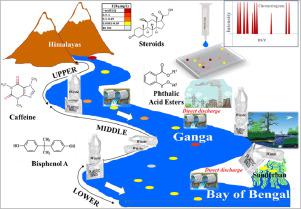Water Research ( IF 12.8 ) Pub Date : 2020-11-23 , DOI: 10.1016/j.watres.2020.116668 Paromita Chakraborty , Nancy W. Shappell , Moitraiyee Mukhopadhyay , Sathaporn Onanong , K Ronnie Rex , Daniel Snow

|
The transboundary River Ganga serves as a conduit for meltwater from the Himalayas and is a major freshwater source for two thirds of Indian population before emptying into the Sundarban Delta, the largest estuary in the Bay of Bengal. Endocrine disrupting compounds (EDCs) such as phthalic acid esters (PAEs) and bisphenol A (BPA) used as organic plastic additives can pollute the aquatic environment receiving plastic litter. Hence, we have investigated these EDCs in water samples from Ganga and Sundarban wetland of India. Since these compounds exhibit estrogenic potential, we have further measured steroids and evaluated the estrogenic activity (estradiol equivalents, BioE2Eqs) using an in-vitro bioassay (E-Screen). Further BioE2Eqs were compared with the sum of predicted estradiol equivalents based on the chemical concentrations of PAEs and BPA by E-Screen (ChemE2Eq) and YES factors (ChemYES). Caffeine was measured as a marker for anthropogenic wastewater discharge. Results showed that the highest BioE2Eq (below the lowest observable effect of E2 on fish) was associated with sites having sewer outfalls in the middle stretch of the river, and concomitantly coinciding with the elevated concentrations of caffeine. Neither ChemE2Eq nor ChemYES correlated with measured BioE2Eqs. River concentrations of BPA (0.04–4.46 µg/L) and ∑7plasticizers (0.43–7.63 µg/L) were higher than BPA (0.21–2.82 µg/L) and ∑7plasticizers (0.85–2 µg/L) in the Sundarban wetland. The only steroids detected were androgens, found at four sites in Ganga (0.007 µg/L± 0.003, mean ± S.D.). The highest estimated ecotoxicological risk to aquatic insect and fish stemmed from BPA. A secondary effect, and a potential impact on human health could be reflected via fish consumption from the productive fisheries region along the lower stretch of River Ganga. Identification of areas of elevated estrogenicity, plasticizer and steroid concentrations in River Ganga can be used to design and implement interventions for the remediation of such emerging contaminants.
中文翻译:

孟加拉湾恒河和桑德班湿地的地表水中增塑剂,双酚A,类固醇和咖啡因的监测:发生,来源,雌激素筛查和生态毒理风险评估
跨界恒河作为喜马拉雅山脉融水的管道,是印度三分之二人口的主要淡水源,然后排入孟加拉湾最大的河口桑德班斯三角洲。用作有机塑料添加剂的破坏内分泌的化合物(EDC),例如邻苯二甲酸酯(PAE)和双酚A(BPA)可能污染接收塑料垃圾的水生环境。因此,我们在印度恒河和桑德班湿地的水样中研究了这些EDC。由于这些化合物具有雌激素潜力,因此我们使用体外生物测定法(E-Screen)进一步测量了类固醇并评估了雌激素活性(雌二醇当量,Bio E2Eqs)。进一步的生物根据E-Screen(Chem E2Eq)和YES因子(Chem YES),根据PAE和BPA的化学浓度,将E2Eqs与预测的雌二醇当量总和进行比较。测量咖啡因作为人为废水排放的标志。结果表明,最高的Bio E2Eq(低于E2对鱼类的可观察到的最低影响)与河中段下水道排污口的位置相关,并与咖啡因浓度的升高同时发生。ChemE2Eq和Chem YES均与测得的Bio E2Eqs不相关。河流中的BPA(0.04-4.46µg / L)和∑ 7增塑剂(0.43-7.63µg / L)的浓度高于BPA(0.21-2.82µg / L)和∑ 7Sunderban湿地中的增塑剂(0.85-2µg / L)。唯一检测到的类固醇是雄激素,在恒河的四个位置发现(0.007μg/ L±0.003,平均值±SD)。据估计,双酚A对水生昆虫和鱼类的生态毒理风险最高。次要影响和对人类健康的潜在影响可以通过沿恒河下游的生产性渔业区域的鱼类消费来反映。确定恒河中雌激素,增塑剂和类固醇浓度升高的区域可用于设计和实施干预措施,以补救此类新兴污染物。


























 京公网安备 11010802027423号
京公网安备 11010802027423号